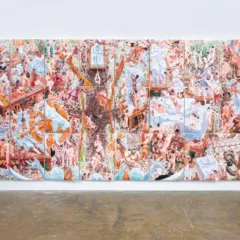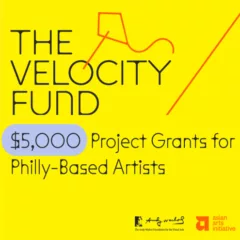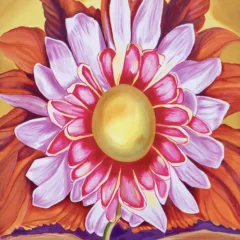Author’s Preface
I am so excited to speak with Co-Directors Natessa Amin, and Anthony Bowers of FJORD on the momentous occasion of their 10th anniversary. Discovering their space when I returned to Philadelphia from graduate school inspired my own curatorial projects, as well as my desire to be a part of an artist-run space. I have been a Co-Director at Ortega y Gasset Projects, an artist-run curatorial collective in Brooklyn, NY since 2017. We also celebrated our 10 year anniversary this year, so I thought this would be a great opportunity to sit down and talk about the history of FJORD, what it’s like to be a part of an artist-run space, and what their vision is for the future. Fjord’s 10 Year Anniversary event was held at Atelier on Saturday, September 16, 2023. You can still support them by making a donation through their Paypal.
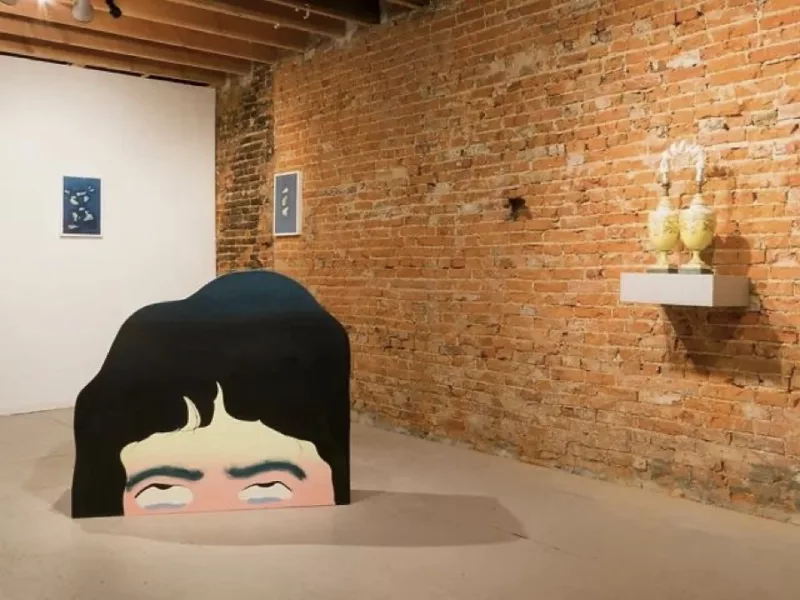
Looking for Studio Space and Creating a Gallery in a Row House
Natessa Amin: So like I said, FJORD was started by a bunch of very young artists that were eager to maintain a community in a new city. So, I believe what happened was that Lindsay Chandler, who was one of the founding members, was literally walking down Frankford Ave one day and saw a for rent sign in the window of a row home. She contacted the landlord, and they agreed to let us rent it as-is, since it was mid renovation and it was a price that was reasonable for I think five or six of us to split.
That’s when the idea for FJORD came about. There were three floors. We broke up the second and third floors into studios and the first floor would be used as an experimental space for showing art. It was very DIY. At the time The Resource Exchange was not too far north from that location so we got all of our supplies and materials to build out the gallery from there. I wasn’t there for the building out of the gallery so I can’t take credit but, the original members Liam holding, Sean Fitzgerald, Leah Morris, Lindsay Chandler and AJ Rombach, all worked together to build out the gallery space and it snowballed from there.
Lauren Whearty: So it seems you were initially just looking for studio space, and the gallery came out of a natural community and desire to exhibit work?
Natessa: Yes, we had all gone to art school together, myself, Leah, and AJ met at Boston University and Lindsay, Sean, and Liam went to RISD. Cameron Masters and Justine Jividen were also early members who were from the RISD group. We all separately had conversations before graduating about trying to start something, without knowing how to do that or what that would look like. When the space presented itself things kind of clicked.
Lauren: I work with OyG, Ortega y Gassett Projects in Brooklyn, who also celebrated our 10 year anniversary this year. Our space began with everyone paying dues to fund the rent and exhibits, which is common for artist run spaces. Were you guys doing the same thing beyond paying your studio rent?
Natessa: Early on, it worked out really nicely because we were just paying for our spaces based on the square footage that we had.
That’s how it worked for the first two or three years, because everyone who was a member had a studio and that money supported the gallery space. Eventually we realized we would need tools and maintenance and upkeep and all of those things. At that point we started to have to shift, but for the first year or so we just scraped together what we could.
Lauren: That’s perfect. Across 10 years it can be very challenging to stay alive and relevant, to change with the times, and be sustainable. Can you talk a little bit about how FJORD has evolved over time?
Anthony Bowers: We started off as a gallery co-op studio model, and then when new members like myself joined, who did not have studios there, we became increasingly interested in becoming a curatorial collective.When we moved to the Crane building, the space again determined what we were able to do. We were able to exhibit solo shows and offer bigger platforms for collaboration among artists. We could have more expensive artwork because we had insurance. All along the kind of spaces that we have inhabited have shifted what we were able to do, but our mission has stayed consistent.
Lauren: When did you move to the Crane?
Anthony: That was 2015 or 16. Yeah,
Natessa: 2016.
New Space Feels Familiar
Lauren: What about now? Where are you located, and what is different about the current space.
Natessa: Now we’re located at 1720 North 5th Street, which is in the newly built-out downstairs area, below the Tie Factory, which is a large residential loft building. It’s interesting because it’s different architecturally from other spaces we’ve occupied but in some ways, it feels familiar. In a similar way to when we moved into Crane, we are one of the first galleries in the new location, so it feels like there’s something that’s being built around as we start this new season of FJORD.
Anthony: Another through line that we’re experiencing in the new space as well is the pace of gentrification and how it’s followed us, like from Frankford Avenue, where we were, which feels like a very different neighborhood than when we first moved in there. Pilot Projects just closed across the street from our new space. I mean, all artist-run spaces run into that.
Lauren: We as artist-run organizations have to be so flexible in order to be a part of a space and keep it going, and to be an artist and keep that going. The number of affordable studio spaces in Philly are reducing at a rapid rate. I think it’s essential to be able to find affordable spaces as the city keeps changing.
Natessa: Yeah, it’s definitely been a challenge.
Lauren: I’m sure. And I’m sure it is not as cheap as it was when you guys started either.
Anthony: Yes, we do more fundraising.
Lauren: What about all of the labor that goes into running these spaces? People show up and see the shows when the gallery is open, but behind the scenes, there’s so much time and energy that goes into a labor of love, like an artist-run space. Can you talk about how you make that work while also having families, jobs, studio practices, and everything else?
Natessa: Yeah, it’s definitely a balance, a juggle. But a lot of us have been part of this dynamic for six, seven years at this point. Part of the way that we’ve been able to maintain this is that we’ve learned what works well for us, such as the right number of people we need to make it work. We also just really trust each other. We respect each other’s time and understand that while this is almost like a second or third full time job at times, we also are artists that all have practices and we have to respect that time as well. I think we communicate really well and that’s a big, big part of how we’ve managed to keep going.
Membership by invitation and holding space for each other
Anthony: I was just going to say that we have never had an open call for new members. We’ve always been very thoughtful about who we invite to participate. That’s created a collaborative community where we can support one another. You know, if Natessa has an upcoming solo show or a wedding and she needs to step away for a few months, we know she’s going to come back and do the work later on in the year. We just can hold that space for each other.
Natessa: Yeah, I love that you said that because I think that holding space for each other has really been a way to show having trust in one another, which has allowed FJORD to keep moving. There have been times when one of us gets a great residency to go away for six weeks and we want to cheer each other on and support each other to do those things. That’s a big part of the community within FJORD that we’ve developed. We’ve really been there for each other. That for me is why we’ve kept it going.
Lauren: In a diverse group of artists, everyone has a different kind of expertise too. It’s nice to have people in your art family or community that, that you can go to for help. Do you have assigned jobs based on skill sets, or are you more flexible about how the workload is done?
Natessa: There are unofficial roles for sure. Our different backgrounds and life experiences outside of FJORD contributes to work at the gallery. We have a professional art handler on the team, which has been very helpful, we have people that work in museums and do development and writing, we have educators and librarians etc.. all of our strengths and weakness crossover and it has been this wonderful place to get experience doing something that you are uncomfortable with or have less experience with.
I’ve learned so much from the other members that have skill sets in the areas that I lack. And that to me has been such a huge part of my art career and growth as a person.
Anthony: We’ve gone through many phases of assigning very defined roles and then drifting away and then back. So it changes. Consistently we try to make sure people have partners to get things done. So if there’s a project or a show, or a grant we need to get done, we form a subcommittee and try to draw on the availability and strengths of different members to support each other. And that’s been helpful for growth and for getting stuff done.
Trial and Error and Learning Over Time
Natessa: Over the years, there’s been a lot of trial and error because there isn’t a guidebook that tells you how to do this. I’m sure you know that. We’ve tested things out where we’re all co-directors or we’ve tried it where 1 of us was a director steering the ship. Those structures worked based on the phases that we were in at any given time, from trial and error to our growth and interests and availability at different times.
Lauren: This conversation helps pull the curtain back a bit on artist-run spaces. It can seem daunting to start something form scratch, or even to join an established space. Do you have advice for those who may be curious about artist-run spaces, or living an artist’s life?
Anthony: One of the things about art that’s beautiful is that it’s countercultural. You don’t get into art to make money. Artist-run spaces are the same way and it is difficult for people outside of the arts to understand what we are doing and why. It’s not a self-advancing, ego-based goal that we’re working towards, it is a community-based goal. I’d say for young artists to just embrace that and to try to do things to build community, not to build skills – the skills will come.
Natessa: Again, community is so important to maintaining a life as an artist. It has been for me. I think everyone that’s a member of any artist-run space has to hold deeply the value and meaning of community. Stick with the people that lift you up and support you. Ask questions and reach out to other spaces. So much of what we’ve done has started by throwing out a question to someone that we never thought would respond. It’s really amazing what can come from taking those risks. Don’t be afraid to ask a lot of questions and utilize the resources within in your networks.
Lauren: I think that’s so empowering.
Anthony: And get an accountant.
Lauren: Yes, absolutely.
Natessa: Yeah, it’s worth it.
Lauren: Agreed. Is there anything you want to add about how moving locations has affected your organization or more broadly, how you’ve had to stay on your toes over the years?
Moving into a new space and adjusting
The Pandemic and Quest for the New Space
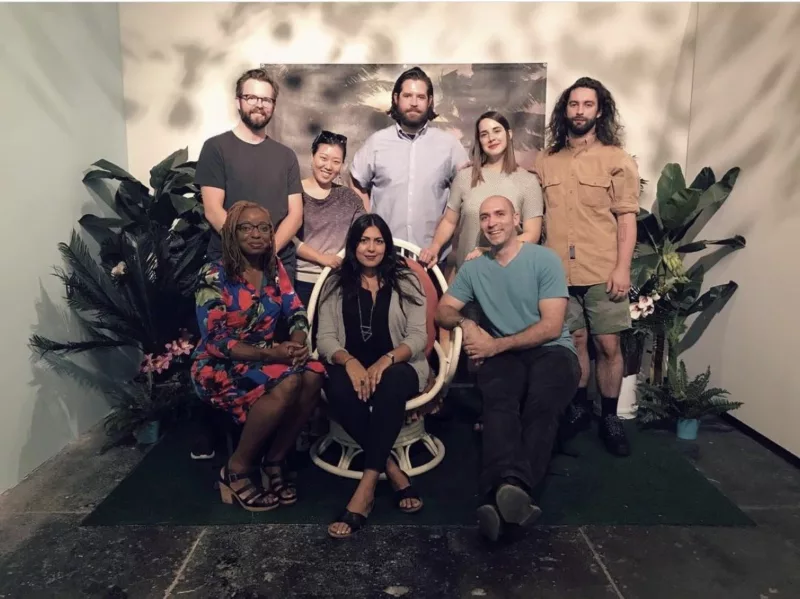
Natessa: Recently we took a little hiatus, we left our space in the Crane because of the pandemic closures. Moving into a new space after this break was like starting again. From trying to find a place that could work within our budget, to considering what we are realistically capable of- to be sustainable. Initially our search felt like dead end after dead end. All of our space changes have been like a direct result of the changing real estate in Philadelphia, for better or worse. We had to move out of our first location because of new development, which luckily landed us in Crane, which was an amazing space to be in and totally changed the ways we functioned and worked together as a collective.
We found our current space through word of mouth after reaching out to lots of different people to see what we could find. In one way it’s been a challenge and other ways it has presented new audiences and new energy. It has also presented a new kind of architectural space to respond to. So it has kept us on our toes and allowed us to react to those changes, but it’s definitely something we’ve had to deal with.
[Author’s Note: *Anthony got kicked out of the zoom and returned*]
Lauren: Anthony, is there anything you’d like to add about, about the different gallery spaces? I think Natessa brought up something exciting in terms of how the space itself can dictate how you install artwork or what kind of work you present within that space.
Anthony: Yeah, I’m sure she made the point better than I could, but yeah, that’s totally true. We’ve found that what your space is really determines what your programming is in a lot of ways.
Natessa: When we moved into Crane, we were like, wait, we can show some huge sculpture here because we have double doors where in our first space, we had to make sure everything fit through this row home front door vestibule. Moving into Crane opened up a whole other set of possibilities. Our new space kind of reminds us of the first space a little in the sense that it’s recently built out. There’s no bells and whistles, but there’s character, right? There are red pipes, and green wooden pillars. That also means that it’s not a space that all artists might want to show their work in. So that’s been interesting to think about.
Anthony: Just to add that, our first show at Crane, we realized we’d never had a solo show before.
Natessa: That’s actually not true. Sorry. We had one solo show at the original space
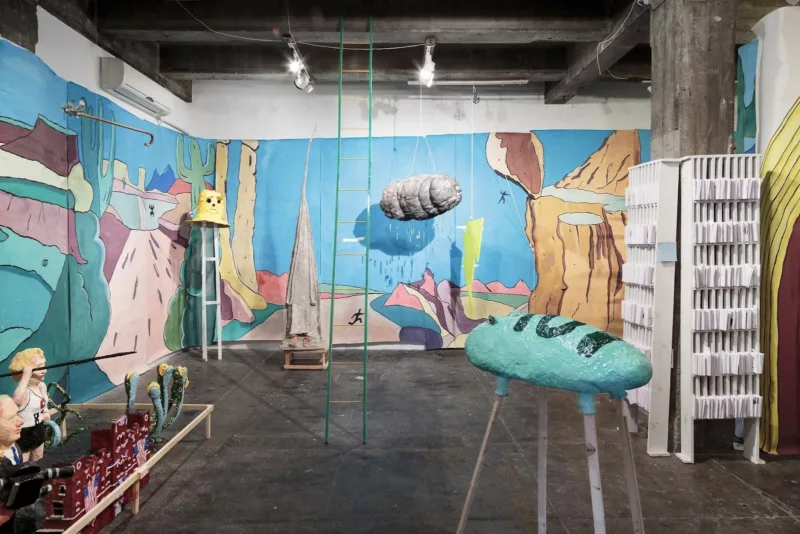
Anthony: Right. We did our second solo show for Matt Freeman who was well into his career. And so it was almost like a retrospective for him. While at Crane were also able to do programming with the Icebox to do a big performance. At a certain point the white boxness of that space started to feel disingenuous, or not quite our speed and so it’s nice to be in some place with a little more character.
Lauren: The nature of artist-run spaces performs so many important services, from breaking down the “gatekeeping” of commercial galleries in giving artists opportunities to try something wild or to get experience and visibility. There’s a real need for these kinds of spaces, it makes the art-life seem more accessible when you see good examples of artists forging new paths, and being able to accomplish large projects with small budgets. Like Anthony mentioned, the counter-cultural element is really important. I’ve learned so much from working on exhibitions with my fellow co-directors, and I wonder if you have any advice or insights that you would give young artists?
Learning and Incubating New Art
Natessa: I have learned a lot about how to maintain a life as a professional artist through FJORD. In art school I was never taught how to install artwork in different ways or really think about display. We had a professional practices courses in my undergrad that taught us how to write a CV and basic artist statements, but there are so many logistics and long term sustaining things you have to do as an artist and I was initially introduced to those aspects of an artist’s life through FJORD.
It feels like this kind of incubation space where we get to try things with other artists. We’re collaborating, and we’re constantly learning from each other. It’s been such a valuable, interesting, and unexpected experience. I think we need more of these spaces and I think these spaces need to exist. So many of the artists we’ve shown have had some of their first shows, like their first exhibition experiences at FJORD. Just having a piece in a group show that introduces them to a whole new network and visibility for their work.
Lauren: I think so much of what we do in artist-run spaces are everyday unsexy tasks, like managing the bank and finances, the movement and packing of artwork, emails and press releases. I think that day-to-day work and preparation is invisible labor but essential to making the space function well.
Natessa: Yeah, absolutely.
Anthony: So all of that’s absolutely true like all the nitty gritty learning experiences and I’d say also just the building of community. When you get out of school you are you are enmeshed in this community that just drops out from under you and it’s really important as an artist to find a network and to do that in a way where you’re giving back to other artists is really positive. Then the experience of being an artist, especially a young artist and talking to curators or professors, and having your work judged and juried, that is so intimidating. And so, the stakes are so high for young people, in terms of their like value in this. But to be on the other side as a curator in an artist space, to be writing about somebody else’s work, to be jurying a show, it’s really empowering for artists and I hope everybody gets the chance to do that at some point, especially young people.
Natessa: Yeah. Yeah. I was just going to say, showing up, if you are interested in the programming of a space, go to those spaces, introduce yourself to the people. Also, if you apply to an open call and don’t get in, apply again. There have been definitely times that we’ve been like, oh, we would love to include this person, but maybe it doesn’t work with the other selected work or the theme of the show or whatever, so they need a smaller show because their work is can’t play well with others.
Anthony: It’s too powerful.
Natessa: Yeah. So, show up and try again.
Lauren: As artists we all have to get very comfortable with receiving rejections from applications, and it can take some practice to build a thicker skin and not take it personally. I wonder if that experience of being on the other end of the process, during an open call, or curating shows changes your perspective on on applying for opportunities.
Natessa: I definitely read the instructions a lot more carefully when I apply to things. It’s such a headache because every application is different. But I’ve realized that it does make a difference to make sure you have followed the instructions and have well documented photographs of your work and that you’re organized and that you’ve read the description of what you’re applying to and what to expect.
Anthony Bowers: I think it just takes some of the sting out of the rejection, you realize it’s all very subjective. It’s not necessarily a reflection on your work even, but definitely not you as an artist.
Natessa: Yeah, definitely. There’s multiple people involved, different perspectives and tastes that are all contributing to the process.
Advice for Starting or Joining an artist collective
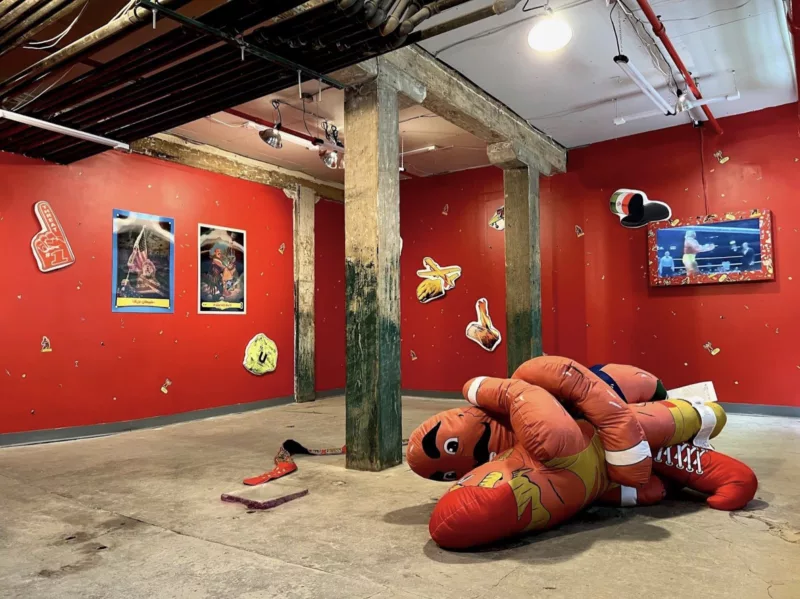
Lauren: I wonder what kind of advice you give anyone who is interested in starting or joining an artist run space?
Anthony: Show up. Just go to the openings. Try to make yourself present to learn, and ask questions-even if you’re starting your own space. Everybody who’s doing this is doing it because they want to build community, and they’re willing to share.
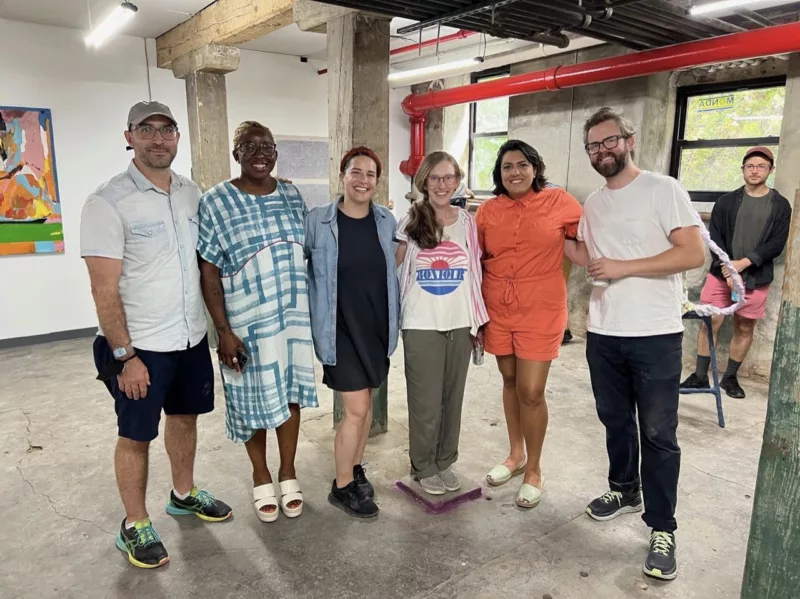
Natessa: Yeah. Yeah, and I think being aware of the expectations. When we are feeling it out to see if someone’s interested in being a member of FJORD, we’re always like, you should recognize that you’re entering into a marriage or a family of sorts, almost, right? It’s not like a nine-to-five job. There’s a Slack ping that goes on at any time of the day. At any given time, you might need to fill in for someone at the last minute or show up to the gallery and open up for someone who wants to see a show, it’s a big commitment. It’s also very rich and rewarding and if it’s something that you’re interested in, I think it’s worth trying and being open to. If you have an idea for getting something started, do it, and like Anthony said, ask for help, ask questions.
Anthony: I think there’s also an impulse as a young artist to put together shows that emulate the sorts of institutions you’ve looked up to in school, like, you know, the ICA or large professional organizations. Just know that you’re different, and you should do weird things your own way, because you’re the space for that. It’s almost like an extension of your practice. An artist curator is different than a regular curator and that’s okay.
Lauren: Well, what about hitting your 10 years? What is your vision for your next steps forward and what projects or possibilities are you guys excited about?
Anthony Bowers: We’re excited for Katie’s show coming up. Katie Wynn is curating a show that opens in October.
Natessa: We also have four recent members, Amy Shindo, Todd Stong, Charlotte Greene and Brice Peterson. We’re just super excited to have four new voices and perspectives and ideas coming to the group. It’s really rejuvenating and it feels like we’re entering a little bit of a new phase of FJORD. We’re excited to see how things evolve forward.
Lauren: Thank you so much for talking shop with me about FJORD, and for being an important piece in the Philly arts community. Congratulations again on your 10 year anniversary. It’s a huge accomplishment.
[Ed. Note: For more FJORD history, listen to an Artblog Radio podcast from 2013 with FJORD co-founders Lindsay Chandler and A.J. Rombach; For coverage of Matt Freedman’s show at FJORD at Crane Arts, see Chip Schwartz’s 2017 review.]



